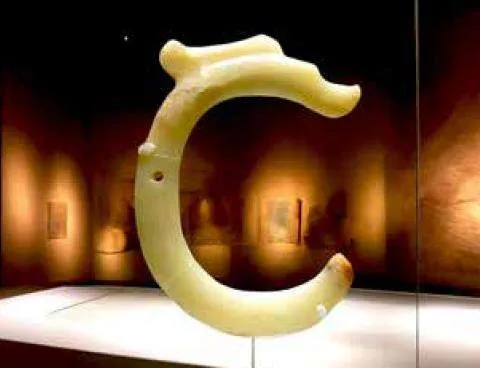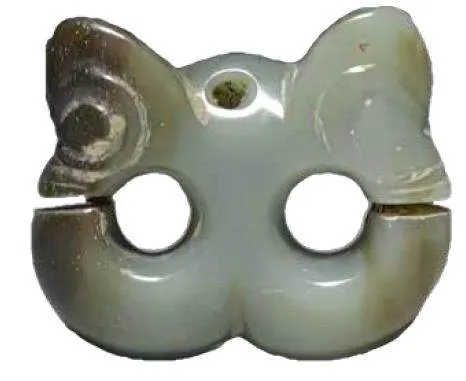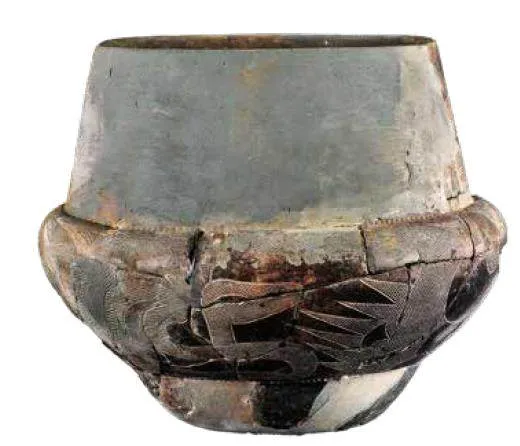红山玉龙:中华文明的曙光
2024-01-01沈莎莎




如果说中华文明是世界上唯一没有中断、发展至今的古老文明,那么,仰韶文化和红山文化则是中华文明的直系根。
If we say that Chinese civilization is the onlyancient civilization in the world that has continuedto develop to this day, the Yangshao and Hongshancultures are its direct roots.
红山文化距今已有五六千年,分布面积达20万平方公里。内蒙古赤峰地区分布较为密集的红山文化遗址被认为是红山文化的主要分布区域,见证了红山文化孕育、形成、演变和发展的全过程。人们在考古中发现了丰富的石器、精美的玉器、极具特色的陶器以及规模宏大的建筑群等,这些出土的文物向世人诉说着红山先民的智慧和才能,也展示了红山文化曾经的辉煌。
The Hongshan culture dates back 5,000 to 6,000years and spans an area of 200,000 square kilometers.The city of Chifeng in Inner Mongolia is dotted withnumerous cultural sites, which are considered themain area of Hongshan Culture. These sites bearwitness to the history of its birth, formation, evolution,and development. Archaeological discoveries haveuncovered a wealth of stone tools, exquisite jadeartifacts, distinctive pottery, and large-scale architecturalcomplexes. These unearthed relics tell the world aboutthe wisdom and talent of the Hongshan ancestors andshowcase the past splendor of the Hongshan Culture.
红山文化各种出土文物中,数量庞大、工艺成熟、种类丰富的玉器是最具魅力的部分。其中最引人瞩目的当属玉龙,它的出现具有重要的意义,向世人证明:以玉为载体的礼制文化是中华文明形成的重要标志之一。
Among the various artifacts unearthed from theHongshan Culture, the jade artifacts, which are vastin number, highly crafted, and diverse in type, arethe most captivating. The most striking among themis the jade dragons, which hold significant meaning,proving that the ritual culture, symbolized by jade,was one of the important markers of the formation ofChinese civilization.
目前发现的红山文化玉龙有两种造型:一种为C形玉龙,一种为玉猪龙。
Two types of jade dragons from the HongshanCulture have been discovered: the C-shaped jadedragon and the jade pig-dragon.
有正式出土地点的C形玉龙目前仅有两件。第一件是1971年在内蒙古自治区赤峰市翁牛特旗赛沁塔拉村发现的,现藏于中国国家博物馆。该玉龙高26厘米,剖面直径2.3 ~ 2.9厘米,呈墨绿色,造型生动,雕琢精美,被誉为“中华第一龙”。
As of now, only two C-shaped jade dragons withverified excavation sites have been found. The firstone was discovered in 1971 in Saiqin Tala Village,Ongniud Banner, Chifeng City, Inner Mongolia, andis now housed in the National Museum of China.This jade dragon stands 26 cm tall, with a crosssectionaldiameter of 2.3 to 2.9 cm. It is dark green,vividly shaped, and exquisitely carved, earning it thetitle of “China’s First Dragon.”
第二件C形玉龙出自翁牛特旗乌丹镇新地村东拐棒沟,现藏于赤峰市翁牛特旗博物馆。此玉龙与前一件形状相同,但形体较小,高16.8厘米,颈部孔径0.7 ~ 0.8厘米,呈黄绿色。
The second C-shaped jade dragon was unearthedin East Guaibanggou, Xindi Village, Wudan Town,Ongniud Banner, and is now housed in the OngniudBanner Museum in Chifeng City. This jade dragonis similar in shape to the first one, but it is smaller,standing 16.8 cm tall, with a neck hole diameter of0.7 to 0.8 cm, and it is yellow-green in color.
C形玉龙造型独特,首尾明显分开,吻部前伸,略向上翘,双目呈水滴状。颈后正中竖起一道勾角,形似飞翔状态的羽翼。下颌底部有阴刻线纹,尾端呈圆弧状。玉龙中部略偏上有一钻孔,若用绳子穿过小孔,将玉龙挂起来,玉龙首尾会处于同一水平线,设计相当周密,人们推测它应该是一种在特殊场合使用的祭祀用品。
The C-shaped jade dragon has a unique design,with its head and tail clearly separated. The snoutextends forward and slightly curves upward, withteardrop-shaped eyes. A raised hook-like ridge,resembling the wings of a flying creature, rises fromthe middle of its neck. There are incised lines onthe underside of its jaw, and the tail curves into arounded shape. Near the upper-middle section ofthe jade dragon, there is a drilled hole. If a cord isthreaded through it to hang the dragon, its headand tail align perfectly on the same horizontal line,indicating careful design. It isspeculated that this jade dragonwas a ritual item used on specialoccasions.
玉猪龙由立体的兽面和玦(jué, 古时佩戴的玉器, 环形,有缺口)形圆体两部分构成,呈圆环形。兽首部位较大,双耳宽厚、直立,前额突出,双眼圆睁,有并列的双鼻孔,吻部突出,吻上和眼周还有表现皱皮的线纹。有的兽面还有突出的獠牙。由于其造型与猪首的形象最接近,故被称为“玉猪龙”,又称为“猪龙形玉玦”。玉猪龙在躯体颈部也有穿孔,可以吊挂佩戴。大型的玉猪龙高约14 ~ 15厘米,小型的高约5 ~ 8厘米,制作比较规范。相比C形玉龙,玉猪龙出土和传世品较多,是红山文化玉器的典型器类之一,广泛分布于辽河流域的红山文化遗址中。
The j a d e pi g - d r agon i scomposed of two parts that forma round ring: a three-dimensional animal head and a ring-shaped bodysimilar to a jue (an ancient jadeornament, circular with a gap).The animal’s head is relativelylarge, with wide, upright ears,a prominent forehead, roundeyes, paired nostrils, and aprotruding snout. Wrinklesare depi c te d throughincised lines on the snoutand around the eyes.Some animals also featureprotruding fangs on face.Due to its resemblanceto the head of a pig, thejade is called “jade pigdragon,”or “pig-dragonjade jue.” The neck of thejade pig-dragon is alsopierced for hanging orwearing. Large jade pigdragonsstand about 14 to15 cm tall, while smallerones range from 5 to 8 cm,all crafted with precision.Compared to the C-shapedjade dragon, more jade pigdragonshave been unearthedand passed down, making themone of the typical jade artifactsof the Hongshan Culture, widelydistributed across Hongshan sites inthe Liao River Basin.
红山先民以旱作农业为主,靠天吃饭,在与天地沟通时,他们往往需要借助相应的器物来表达对天地的敬意,脱胎于山川、汲取万物精华的玉便成为最好的选择。中国人自称“龙的传人”,龙文化深深印在民族基因里。古时,人们认为“龙”是神圣的,能够驾驭风雨雷电,因此希望通过玉龙来祈雨和祈求丰收。新石器时代红山文化遗址出土的玉龙是中国龙图腾最早的实物。红山玉龙是红山文化的象征,也是内蒙古的一个文化符号。
The ancestors of Hongshan mainly relied on dryfarming, lived off the weather, and often needed touse certain objects to express their reverence for thenature. Jade, formed from the essence of mountains and rivers, became the perfect medium. The Chinesepeople refer to themselves as the “descendants of thedragon,” with dragon culture deeply ingrained in theirnational identity. People in ancient times believedthat dragons were sacred, capable of controllingwind, rain, thunder, and lightning, and thus used jadedragons to pray for rain and a bountiful harvest. Thejade dragons unearthed from the Neolithic HongshanCulture sites are the earliest physical representationsof China’s dragon totem. The Hongshan jade dragonsymbolizes the Hongshan culture and is also acultural emblem of Inner Mongolia.
红山文化展现了中国北方地区新石器时代文化的特征和内涵,体现了中华文明的多源性。在这里,我们看到了中华五千年文明的曙光。之后的几千年里,这一抹曙光与中原地区其他古代文明互相影响、融合发展,共同照亮了整个华夏大地。
The Hongshan Cul ture showcas e s thecharacteristics and essence of Neolithic culture innorthern China. It reflects the multi-origin natureof Chinese civilization. It can be regarded as thedawn of the 5,000-year Chinese civilization. Overthe following millennia, this initial light intertwinedwith other ancient civilizations in the Central Plains,influencing and merging with them, illuminating theentire Chinese land.
